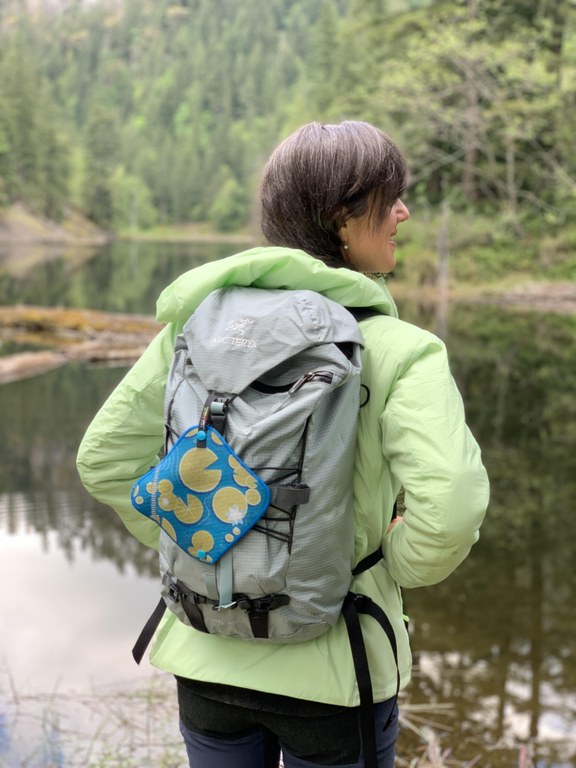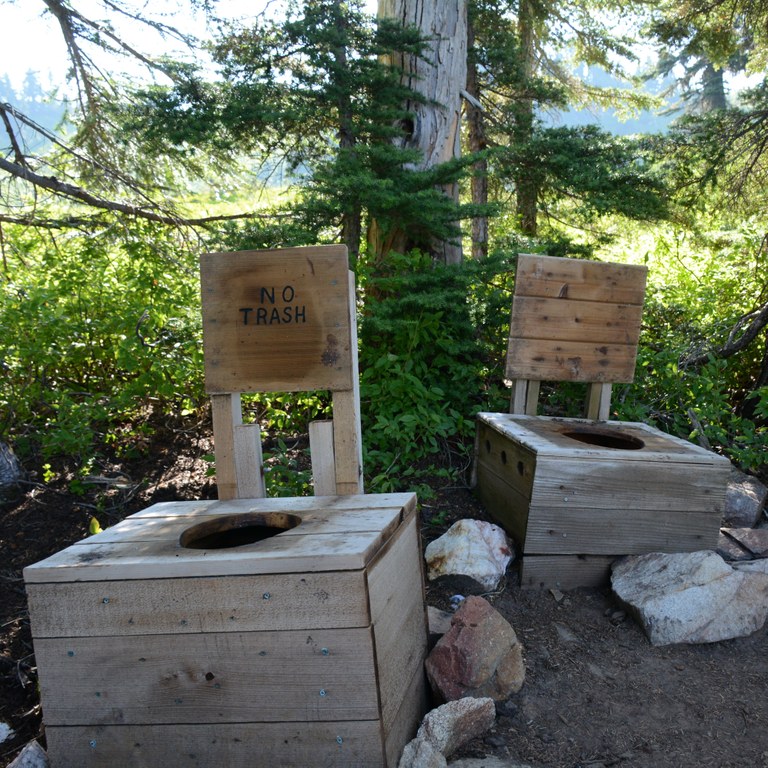How to Use the Bathroom Outside
By Sandra Saathoff
It’s going to happen. You’re out for a hike, whether for a few hours or days, and nature calls. No, not the call of the mountains, the even-more-urgent call of the bathroom. But you’re outside — there’s no bathroom for miles. What do you do? We’re here to give you some tips to make peeing and pooing outside a little easier.
The first rule is to always be prepared — a trowel and wiping material, along with a way to pack out toilet paper — should always be in your pack.
The next rule: In order to avoid contaminating sensitive or high-traffic areas, you’ll need to walk approximately 200 feet away from the trail, campsites and water sources. That’s about 65 to 70 steps. Make sure you take a good look around and know how to get back once you’re done! Now for the good stuff.
How to pee outside
Choose a location: You’re looking for a soft, highly absorbent location with a little privacy. Pine needles and areas where there are decomposing logs are both great places to pee. If you’re in a location where mountain goats are nearby, choosing to pee on a rocky surface will keep fragile soil from being disturbed by ungulates seeking salt.

A pee rag is handy addition to your hiking gear that can dramatically cut down on how much toilet paper you have to bring and pack out. You can make your own, or find one pre-made. Kula Cloth can be found at kulacloth.com. The art on the cloths often features outdoors artists. The lily pads are by Latasha Dunston, @jitterbug_art.
Think about clothing: If you’re standing up to pee, this is likely no issue for you. Just choose an appropriate location and move any clothing out of the way. If you’re squatting to pee, the rest of this section is for you. Once you have found your location, drop your shorts and squat, making sure that all clothing items and shoelaces are out of the way. Once finished, lots of people espouse the “shake dry” method, but I’ve never found that to really work — I always end up with some moisture on my underwear. If I’m out long enough, it doesn’t smell great and can lead to a urinary tract infection. Many people prefer to wipe for that reason alone.
TP etiquette: We’re used to toilet paper, because we’re used to having toilets in our homes, but in nature, we can’t just wipe and drop. Believe me, nobody likes to come across used toilet paper in the wild. This means that if you’re going to use TP in the forest, you need a bag to contain it until you reach a garbage can.
Hand sanitizer: Whether it’s #1 or #2, make sure to wash up once you’re finished.
Helpful Tools for Peeing Outside
Pee funnels: If dropping trou in the middle of nowhere is not your thing, perhaps a pee funnel is. Funnels are basically plastic devices that fit to your parts and then extend outside your clothing to enable peeing when standing up. They come in many shapes and sizes, and as bodies also come in various designs, it may take a bit to find what works best for you. They range in price from $10 to $26 and can be found online and in some outdoor retail stores. Regardless of which you choose, you’re going to want to practice at home in the shower before heading out on trail.
Pee cloths: Another option is a piece of fabric specifically designated as your personal urine wiping instrument for your time outdoors. For ease of use, hygiene and Leave No Trace, a pee rag is the way to go. It can be as simple as a bandanna or a pre-made cloth with an anti-microbial inner layer, water-resistant outer layer, hook-and-loop closure and a nice loop to attach to a carabiner on the outside of your pack. If you’re out for a day, wash it when you return home. If out for a week, it can be rinsed along with other laundry you might do in a bag with clean stream water. (Make sure not to wash in the water source.) Designed pee cloths are available from a few different online shops or in some outdoor retail stores, with prices ranging from $13 to $28. Or, if you are crafty, make your own.
How to poop outside
Pooping in the woods can cause some anxiety — but it doesn’t have to. Certainly, it’s a skill to learn and one that can take a little practice, but it can be kind of liberating. There are plenty of euphemisms for the act, but whatever you call it, make sure you’re ready to roll when it’s time to go. For a simple crap in the woods, you’ll need the following: wiping material, a digging implement, possibly a bag and hand sanitizer.

A full kit of backcountry bathroom essentials. Photo by Charlie Wakenshaw.
Choose a location: If at all possible, use a privy. It’s the most environmentally friendly method. It helps to do some research before your trip to know if there are privies along your route. That said, there aren’t privies in some locations, in that case, you’ll need to choose an appropriate spot. If possible, choose a location with easily diggable soil. If the ground is too hard to dig, even after looking for several minutes, try lifting a rock. Often there’s good dirt beneath.
Dig a hole: Using your trowel (or a stick, tent stake or rock), dig a hole at least 4 inches wide and about 6 to 8 inches deep. If I’m camping overnight, I will often pre-dig my hole, so that it’s ready in the morning.
Get into position: Position yourself so that you can squat without tipping over. Then, bare your bum and position yourself over the hole, making sure that all clothing items, boot laces, etc. are out of the way.
TP etiquette: Use as little toilet paper as necessary. It’s best to pack out your TP. You’ll want an extra plastic bag to scoop it up and contain it, much like a dog poo bag would, and you may even wish to put some duct tape on the bag to hide its contents from view. If for some reason you have to leave TP behind, use a stick to make sure to give it a good stir with the contents of the hole when you’re done. This allows it to break down quicker and ensures that pieces of TP don’t end up being dug up and distributed in nature. Nobody likes to see that.
Cover the hole: Make sure to completely backfill the hole with the dirt you dug. Tamp it down with your foot and try to make it look natural. Some people place a rock or branch over the spot to discourage critters.
Hand sanitizer: Whether it’s #1 or #2, make sure to wash up once you’re finished. You don’t want the contents of the hole to make their way into your bag of trail mix.
Other considerations
Blue bags: Some high-traffic areas, usually at high elevation or in sensitive or rocky areas, require people to pack out their poo. One good way to do this is by bringing what’s known as a “blue bag” or “wag bag” — think dog bag kit for humans. Easily purchased online or in outdoor retail stores, they generally contain a puncture-resistant bag, a little TP and hand sanitizer. Inside the bag is a solidifying agent that hides smells and helps the contents break down. The bag serves the same function as the “cat hole” you would dig — you poop right into it. You can do this by spreading it out on the ground, or even anchoring it between rocks. Carry out your waste and dispose of it in the trash once you return to civilization.
Once you’ve mastered the art of the backwoods bathroom, you’re ready to head for the hills, knowing that when nature calls, you’ll be ready.
WTA's TIPS FOR DIAPERS AND DOG WASTE
Diaper tips: If you are backpacking with a baby, you will have to create a system for diapers. Always pack out dirty diapers. Do not burn or bury diapers, which is very harmful to the environment.
- When packing for your trip be sure to pack more diapers than you think you will need and realize that they will be heavier (and bigger) when you pack them out than when you pack them.
- Dirty diapers wrapped tightly in plastic bags helps to keep the smell down.
- Cloth diapers can be laid out in the sun to dry before being wrapped.
- Follow the lead of one family who has created a hybrid reusable/disposable system.
Dog tips: When it comes to dogs, you have two options: bury it or pack it out. Pack a trowel and bury the waste as you would your own. Alternatively, pack it out in a plastic baggie.
- If you're packing pet waste out, keep the baggie with you. Don't stash it alongside the trail or leave it hanging from a tree. (If you don't want to carry it in your pack for the whole hike, get your dog a backpack and have your pup pack it out.)
- Keeping your pup on leash will help you keep track of where she does her business.
Keep learning
Get into the finer points of this Leave No Trace basic with the resources below. When do you need to pack it out? When and where should you bury your business following Leave No Trace principles? Watch the video below, and learn how to do it right.
- The story behind backcountry privies.
- If you want to learn more about the subject, a good place to start might Kathleen Meyer's classic How to Shit in the Woods: A Sound Approach to a Lost Art.
- Check out all of the Leave No Trace guidelines.
- Learn backpacking and overnight camping basics on our Backpacking 101 page.


